Designing the Magic: The Gathering® – Fallout® Commander Decks
Hello! I'm Annie Sardelis, lead designer of the Magic: The Gathering® – Fallout® Commander decks. Fallout is a role-playing game set in the nuclear post-apocalypse from award-winning Bethesda Game Studios, and it's one of my absolute favorite series. Years ago, when walking through a DC metro station, I stared up at a huge advertisement for Fallout 3 featuring a Brotherhood of Steel soldier in power armor. From then on, actual DC felt so mundane when I could be in the Capital Wasteland listening to Three Dog while blasting super-mutants.
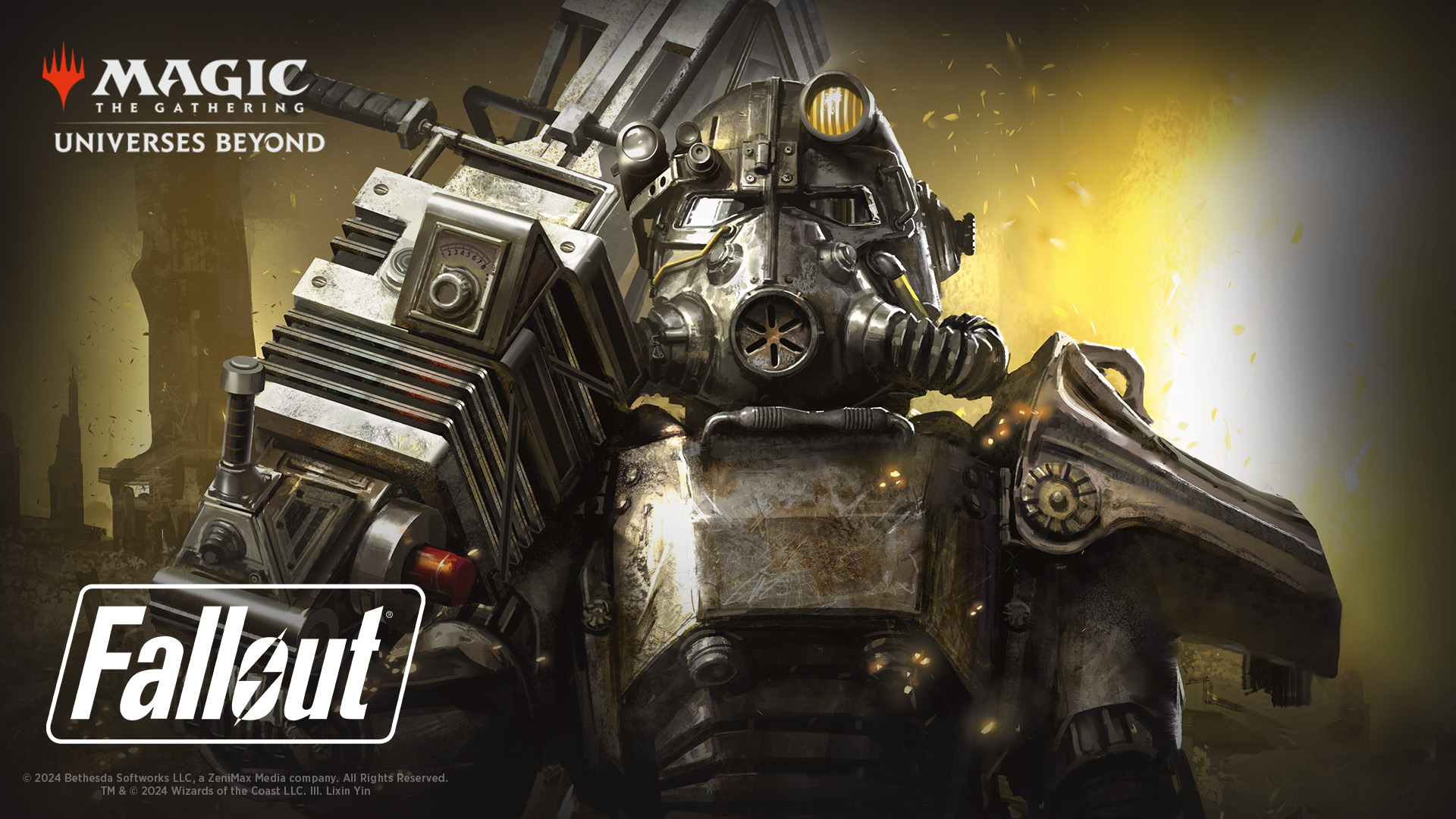
A short intro to Fallout for those unfamiliar: Fallout is a role-playing game set in the nuclear post-apocalypse. The games are set in an alternate future where nuclear power got out of hand, causing both vast technological advancements but also the near-total destruction of the world. Remnants of humanity survived in underground Vaults to emerge to an irradiated wasteland. Each Fallout game explores a different region of America where fragments of the past can still be found—monuments, supermarkets, soda factories, drive-in theaters, and more.
Despite the war-torn history of the Fallout universe, the games are very fun to play, and even funny at times. Don't get me wrong, there's serious stuff to deal with—mutant monsters, irradiated food, ruthless raiders … But there's so much charm and strangeness to the world that you can't help but fall in love with it, rads and all. The biggest challenge became fitting as much of this awesome stuff as we could into these four decks.
Let me introduce my companions who made this set possible:
First is Ethan Fleischer. Ethan leads our design philosophy for all things Universes Beyond. His experience heading both The Lord of the Rings: Tales of Middle-earth™ and Warhammer 40,000 Commander decks helped us mesh Magic and Fallout together to bring out the different strengths they both have to offer. I'd previously designed a few Commander decks under Ethan's lead and was able to take that knowledge and really run with it here. Thanks, Ethan! Favorite Fallout song: "Maybe" by The Ink Spots.
Daniel Holt hadn't played a Fallout game before joining the team but has lots of Commander design experience. When tasked with designing the Mutant Menace deck, he went head first into mutant lore, emerging covered in FEV (Forced Evolutionary Virus) and with lots of ideas for unique creature designs. Daniel is super in tune with the Commander community and helped us to target cool designs for Magic players at large. Favorite Fallout song: "Pistol Packin' Mama" by Bing Crosby and The Andrew Sisters.
Reggie Valk had his first spin on a Commander team with Fallout, spearheading the Hail, Caesar deck. I'm just happy I could get him to stop playing Fallout: New Vegas for a bit to work on this set. Whenever you see a top-down design and think "of course it does that," the culprit is likely Reggie. Favorite Fallout song: "Big Iron" by Marty Robbins.
Chris Mooney is another Fallout subject-matter expert and used that knowledge to design a bunch of the more-niche legendary characters. They created the Science! deck and helped me workshop the Scrappy Survivors deck to find the design gaps to make these decks fun and functional. Favorite Fallout song: "The Wanderer" by Dion.
And me! I led design for the Scrappy Survivors deck and wish I were in the Tunnel Snakes, because they rule. Favorite Fallout song: "Grandma Plays the Numbers" by Wynonie Harris.
I also want to give a big shoutout to our creative team of art directors (led by Matt Cavotta), creative text writers (led by Dillon Deveney), and worldbuilding game designers (led by Miguel Lopez). They nailed the tone of the series through art and flavor text. Editor Del Laugel for making sure our crazy cards make sense. Also, Zakeel Gordon, our product architect, who took every opportunity to make this product awesome.
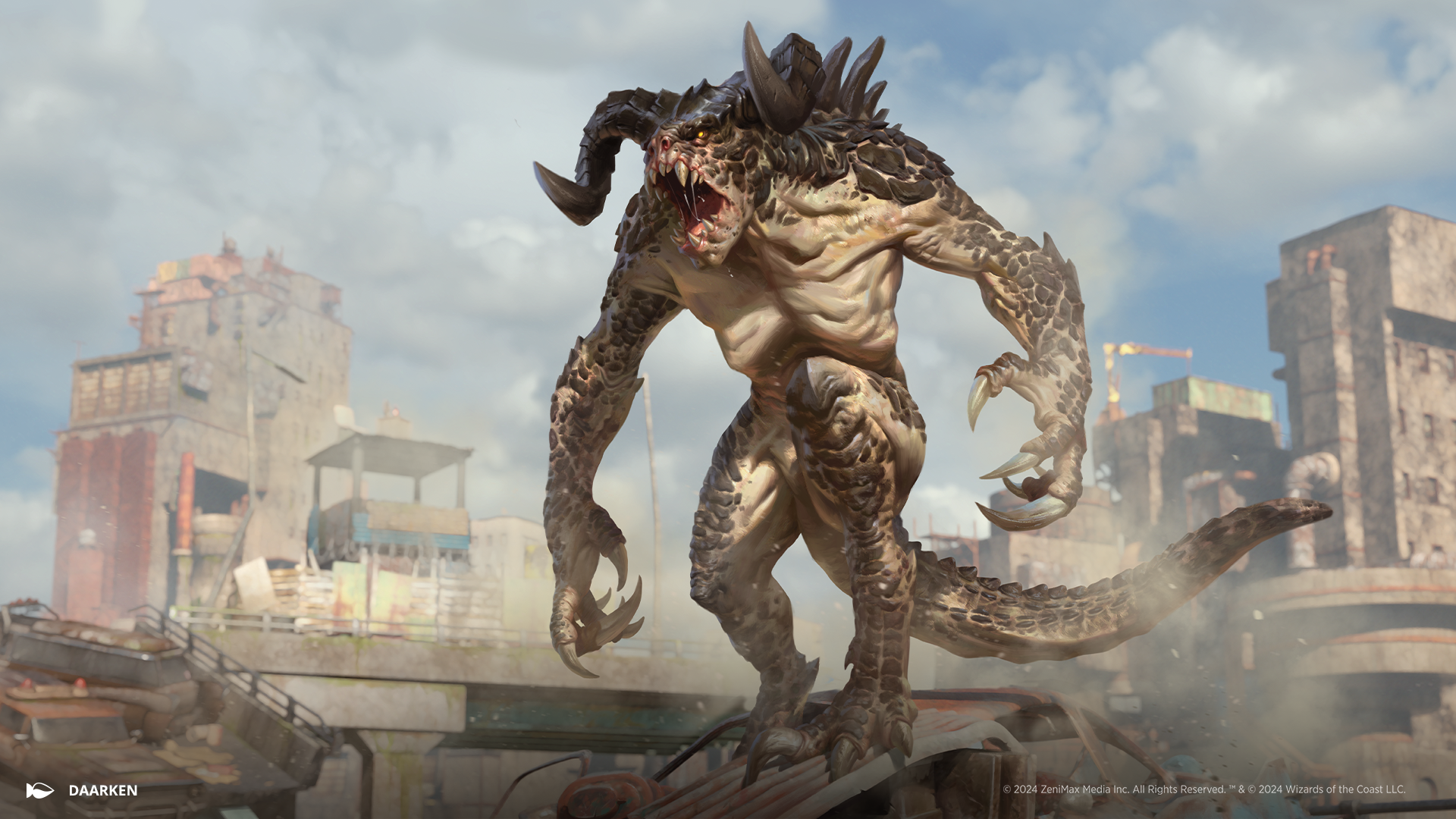
Ground Zero
When starting the project, the first thing we had to figure out was how to divide up the world of Fallout into four decks. We wanted to include content from each mainline Fallout game, which includes Fallout, Fallout 2, Fallout 3, Fallout: New Vegas, Fallout 4, and Fallout 76. We also wanted to showcase the factions, such as the Brotherhood of Steel, the New California Republic, the Enclave, the Institute, and more. The combination of these became a little tricky since each game is set at a different point in time and at different regions across America. Depending on the game you play, some of these factions might not be seen or exist, or their philosophy has changed over time. While you can tell the decks map to certain games or factions more than others, we chose to capture more general chunks of the experience of playing a Fallout game. After all, it was a huge world, and as the team designed their favorite characters, events, and more, I always wanted there to be a place where that card could exist.
Let's talk about a few of the design decisions made when working on these decks, as well as our new mechanics.
Scrappy Survivors
I had one non-negotiable character when it came to our face legends: Dogmeat. Dogmeat comes in a few shapes and sizes but is always the best dog. This got me thinking about who "we, the player" are in a game of commander, as I usually associate this with my chosen commander legend. We thought about having card analogs for the Fallout player characters such as The Chosen One, The Courier, The Lone Wanderer, etc., but as Fallout allows you to have so much agency over who these characters are and what they do, it was challenging to settle on what exactly their cards would be about. So rather than a player character, we emphasized the non-player characters. Because those characters have their own stories and motivations, who you choose to travel with often says a lot about how you like to play the game. For example, everyone who has hung out near Preston Garvey knows how important those settlements are to the Minutemen, so we designed his card to enchant your lands with Settlement Aura tokens. I like to think that we captured how it feels to be The Vault Dweller as the person piloting the deck, with your chosen companions and deck-building choices to express yourself, not unlike role-playing in the Fallout game itself.

Dogmeat … fetch!
The next goal was to find mechanics that felt uniquely Fallout. Using how it feels to scrape by in the apocalypse, I wanted to have some kind of artifact token to represent all the junk left behind in the world from before the bombs fell. Treasure tokens clearly mapped to bottle caps (the currency of the world), there are a lot of unique food items for Food tokens (crispy squirrel bits, Cram, etc.), but there was a gap for what a desk fan, roll of duct tape, or a toothbrush represented. I had to do Trashcan Carla proud. The new Junk token allows you to dig into your deck to try to find something useful to play that turn. You may want to save it for later turns where you'll have mana to cast the card you exile, or you might want to see all your options first before making your move. Junk may sound, well, like junk, but it's surprisingly useful in Fallout—selling for caps, modding weapons and armor, or crafting a shelter. So, get out there and collect some junk!
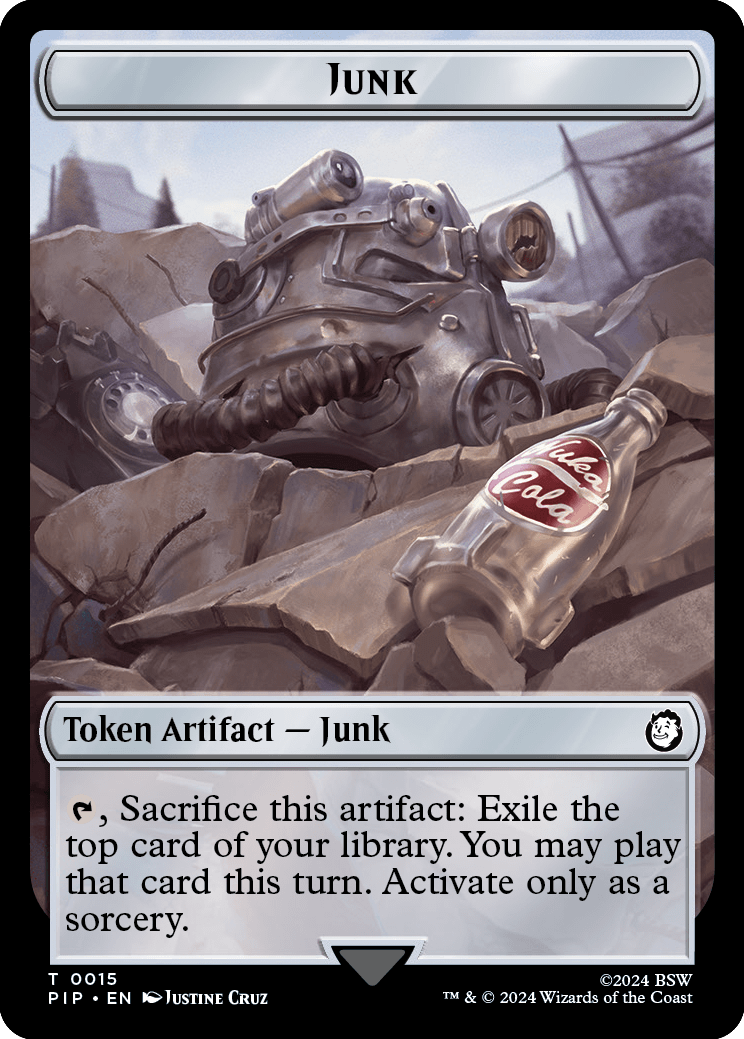
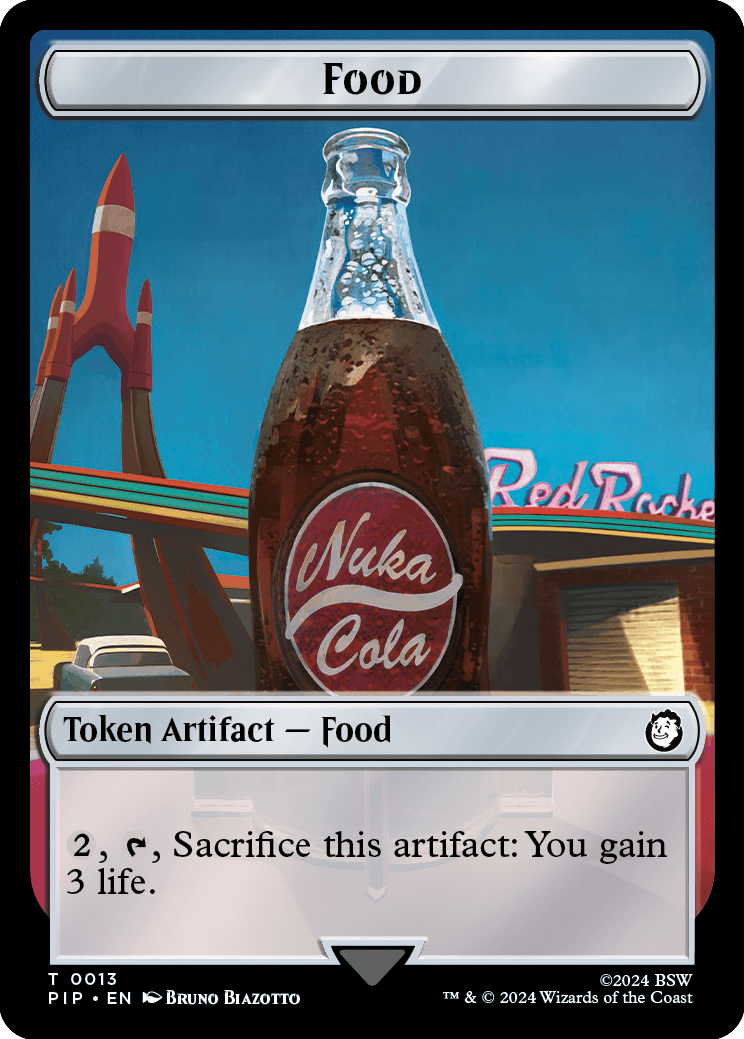

Mutant Menace
Speaking of new mechanics, let's talk about our most ambitious debut: rad counters. In Fallout, nuclear radiation has entirely warped the landscape. To address the rad-elephant in the room, the rules of mutate itself just didn't map well to the creation of mutants in Fallout—humans as well as animals (non-humans) experience mutation. This left me with wanting to find something equally ambitious and unique, as rads are something you must deal with in every Fallout game. Keeping in line with the thesis of "you are the player character," I wanted to irradiate players. In Fallout and Magic, you have a life total (hit points), so naturally, you should also have to track your rad total.
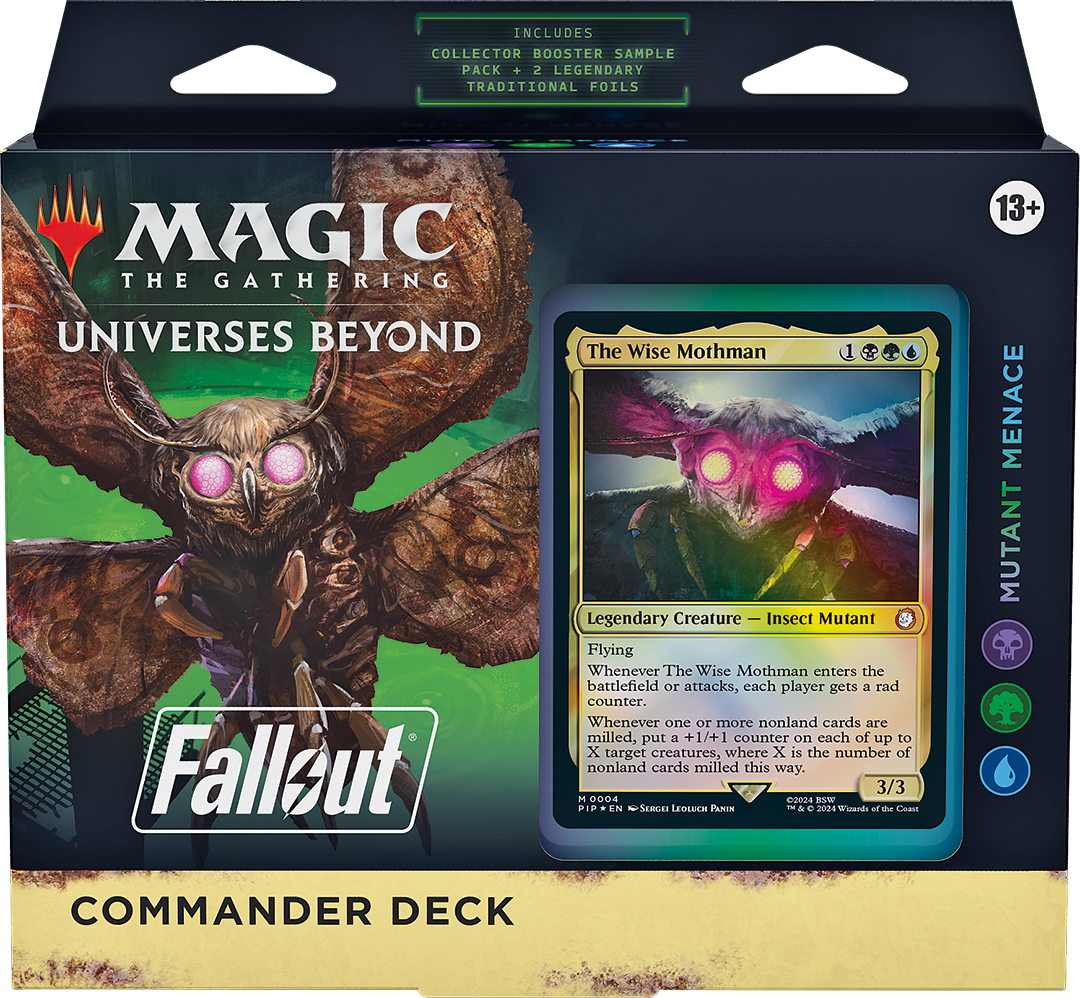
How could you not love those glowing purple eyes?
The rules of radiation are "At the beginning of your precombat main phase, if you have any rad counters, mill that many cards. For each nonland card milled this way, you lose 1 life and a rad counter." Chris Mooney developed the details of rad counters to make you lose life in a non-deterministic way. This way, even if you have rad counters and are low on life, you still have some hope to survive to your next turn. At one point, we played with removing half of your rad counters as a reference to half-life, but the pause it caused in gameplay to do the bit of math ended up not worth it. Rad counters are not great if they are on you as a player, but lots of your Mutant creatures get powered up by rad counters, such as Mirelurk Queen and Screeching Scorchbeast. This dichotomy helped express how rads influence the world of Fallout and gave the playstyle of the deck more texture. Proliferate, graveyard matters, +1/+1 counters, mill, and self-mill all became angles we could design new cards around as well as find reprints for.
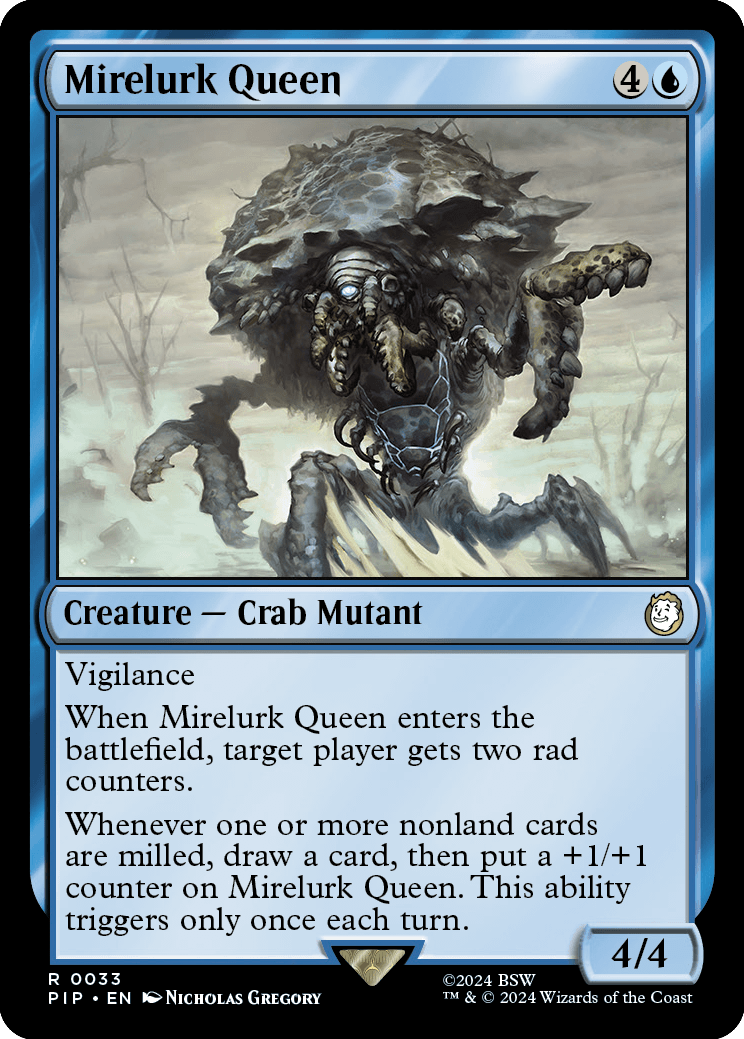
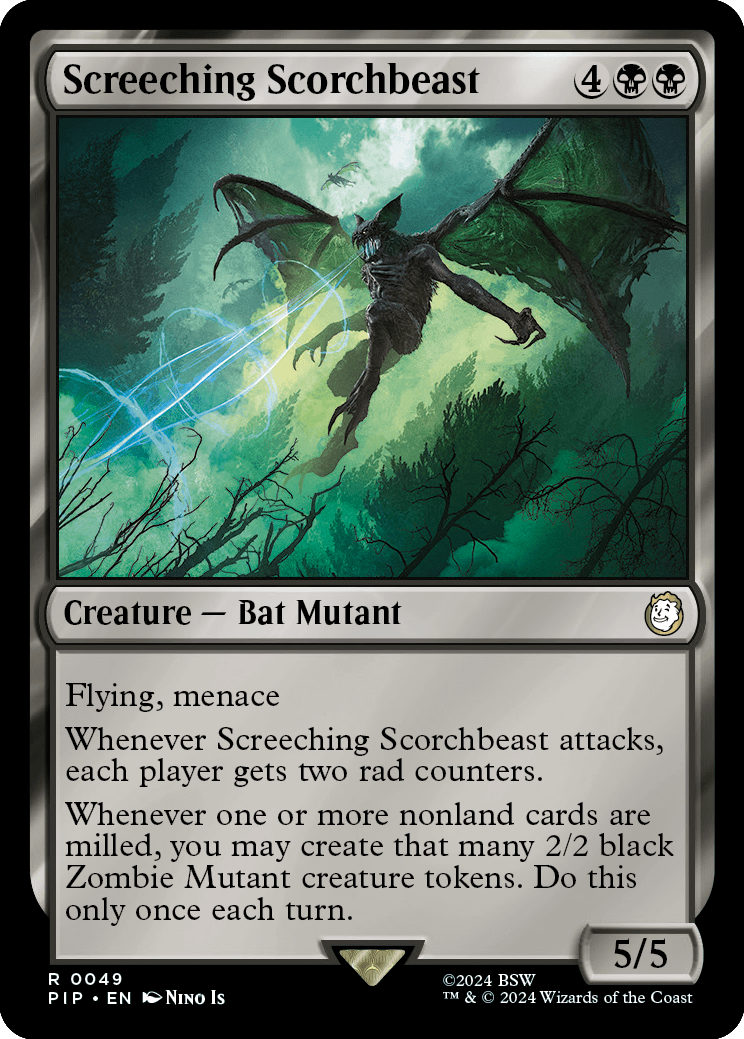
Science!
Fallout's tone is defined by its juxtaposition of optimistic retro-futurism and the horrors of an irradiated wasteland. You'll see the ruins of idyllic suburbs with a deathclaw walking down the street. There's the cheesy smiling Vault Boy instructing you about the horrors of the wasteland. And then there's the cobbled-together shelters and weapons juxtaposed with the futuristic pre-war technology of power armor, robots, and lasers. The Brotherhood of Steel and the Institute keep this tech for themselves, so outside of joining one of these high-tech factions, you're going to be doing a lot of scavenging (or looting of folks from these factions). That left us looking at a resource that's scarce, valuable, and used to power up your tech. Going through Magic's existing suite of resource mechanics with that in mind, energy counters were a great fit.

Dr. Madison is one of the few characters found in both Fallout 3 and Fallout 4!
The pool of reprints utilizing energy counters was rather shallow, which was both a challenge and an opportunity. It meant we had space to make new cards, but we also needed to have a way for the deck to "fuel" itself with energy counters without relying on reprints. The solution involved using artifacts as the primary way to generate energy counters, which can be seen on the face commander Dr. Madison Li and the featured commander Liberty Prime, Recharged. This allowed us to rely more on artifact reprints and popular artifact token types to support the deck. Also: robots are awesome.
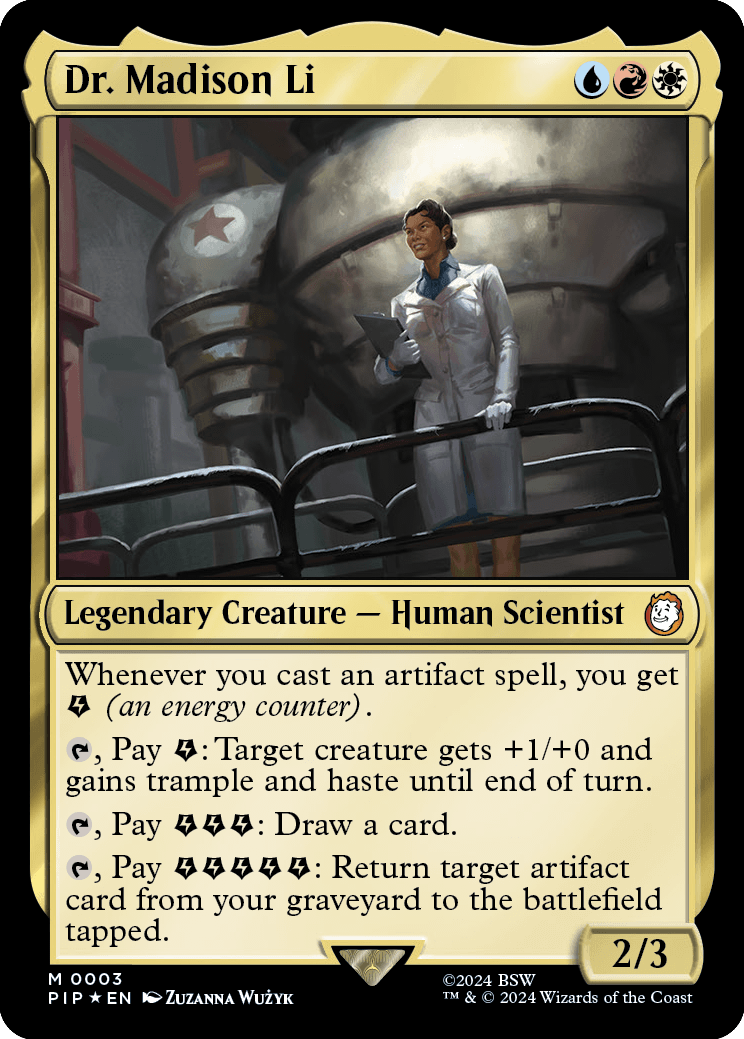
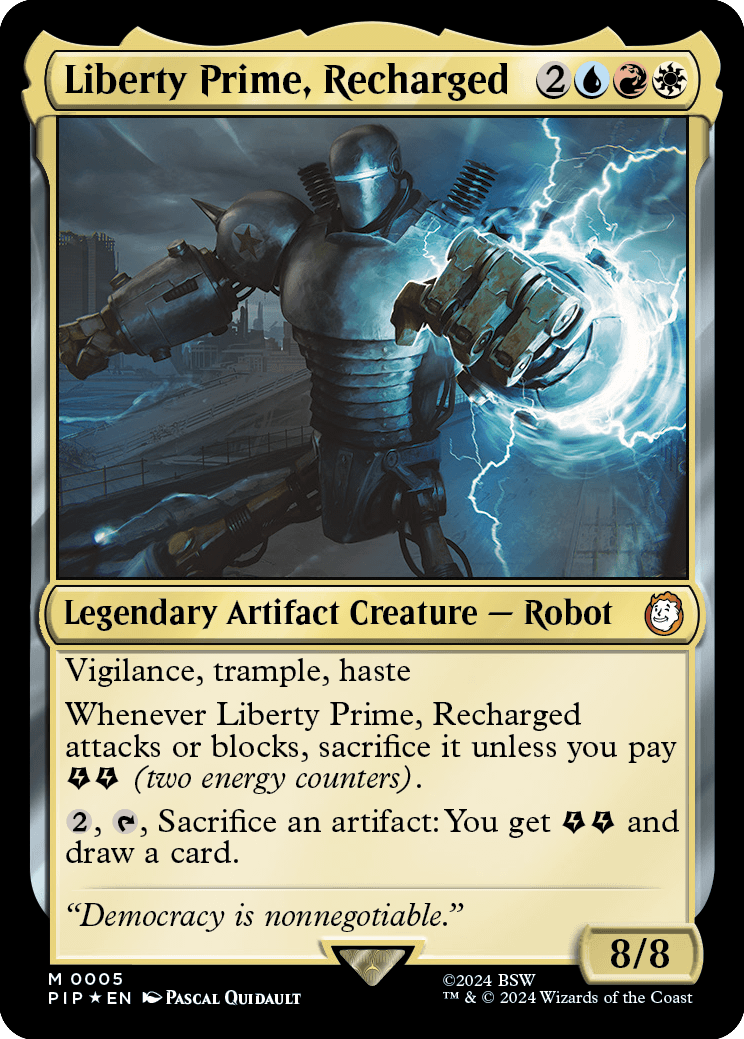
Hail, Caesar
One of the best ways to survive in the wastes is to team up with others. From raiders to armies to mercenary bands—there's undeniable power in numbers, which ties these groups together. While Caesar is the head of this deck, there are a bunch of different militant factions besides the Legion represented in the deck. Role-playing games are often full of jerks that you can blast to pieces without remorse, but Fallout is unique because several of its games allow you to join these jerk factions. Caesar's Legion is one of the most well-known examples of this. Caesar leads like a dictator—he's smart, charismatic, and has his massive army do the dirty work for him. We captured this by allowing his card to hang back while you attack with your other creatures, growing your ranks and accruing resources. It was also a fun coincidence that we could use Assemble the Legion from our own Ravnica as a reprint.

When you take the Roman L.A.R.P. too seriously.
While this deck is a go-wide strategy, we wanted the tokens you make to be more diverse than 1/1 creatures (though the deck still has plenty of those expressing various kinds of soldiers and raiders). We decided to return to the squad mechanic, which debuted in the Warhammer 40,000 Commander decks. This mechanic allows you to create whole armies out of a single creature and put card text on those creatures to give them more impact and texture. There's nothing more terrifying than a whole squad of Garys.
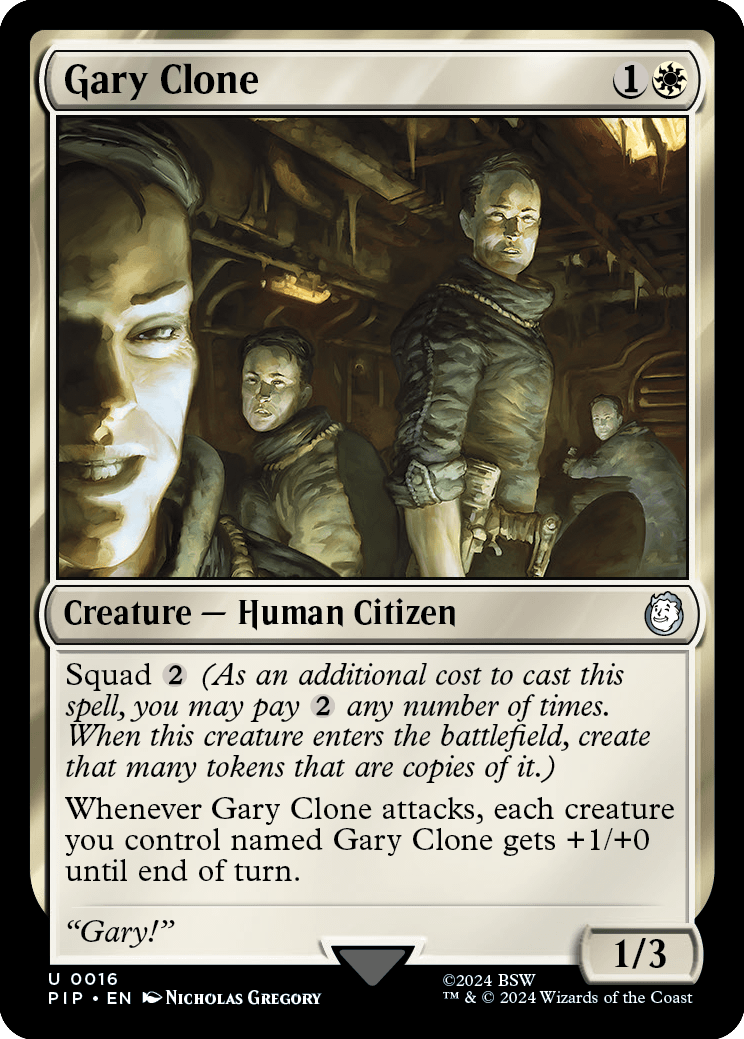
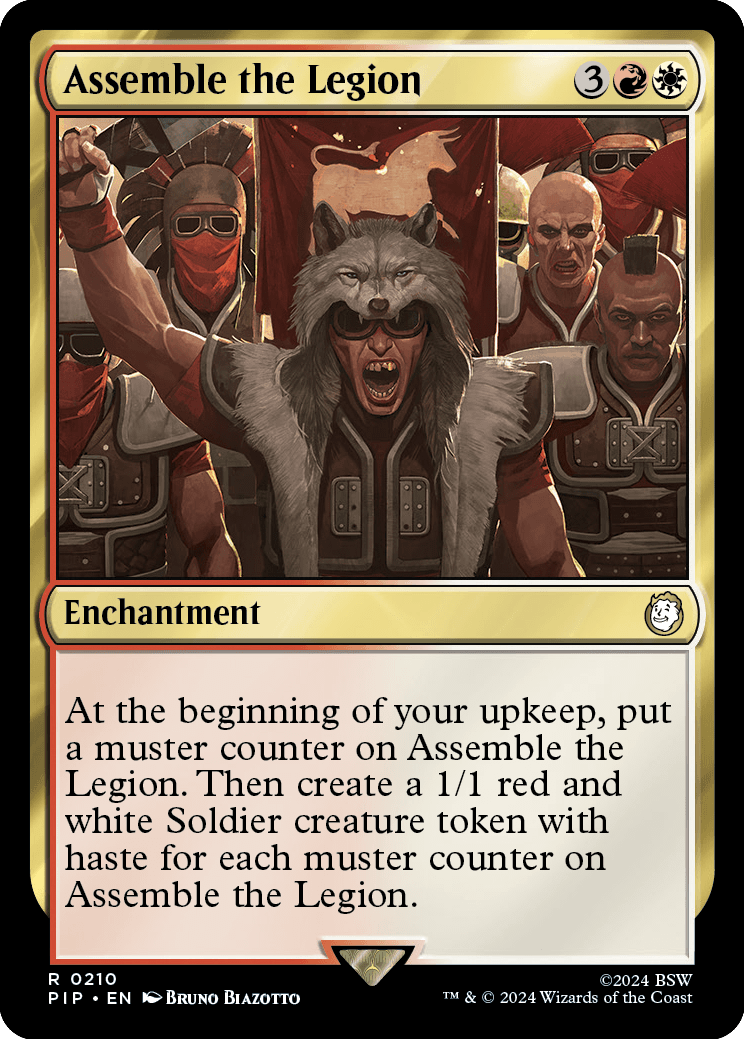
[Everyone Liked That]
Taking aspects of Fallout, not just as a world but as a game, and translating them to Magic is my personal highlight of the set. We have perks in the form of different Auras, serialized Bobbleheads for collectors, rad counters, Junk tokens, V.A.T.S., and more. In Mark's article "Game On," he goes more into how we approach this in our Universes Beyond sets. Making these decks was some of the most fun I've had designing cards for Tragic the Garnering Magic: The Gathering, and I hope you have fun playing with them!

